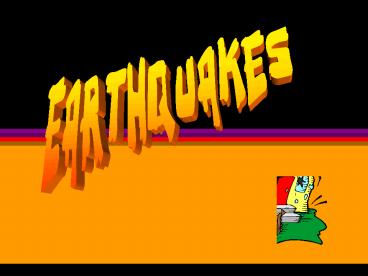Unit 8 Notes - PowerPoint PPT Presentation
1 / 36
Title:
Unit 8 Notes
Description:
Earthquake waves are recorded by a seismograph and the recording of waves on ... wave and the S wave to the seismograph station is converted to a distance (miles ... – PowerPoint PPT presentation
Number of Views:57
Avg rating:3.0/5.0
Title: Unit 8 Notes
1
Earthquakes
2
What is an Earthquake?
- Earthquakes Vibrations (seismic waves) within
Earth materials are produced by the rapid release
of energy - Earths crust is in constant motion because of
tectonic forces - Earths crust can store elastic energy
- When forces exceed the elastic limits and
structural strength of the rocks, the rocks will
break and/or move producing vibrations that
travel outward in all directions
3
Earthquakes
- The actual place underground where the rocks
break producing vibrations is called the focus. - The place on the surface directly above the focus
is called the epicenter.
4
(No Transcript)
5
What types of forces are created?
- Tension Force/Stress
- stretching or pulling force
- Makes a normal fault
6
Normal Fault
http//www.geo.uib.no/jordskjelv/index.php?topice
arthquakeslangen
7
What types of forces are created?
- Compression Force/Stress
- force pushing something together
- Makes a reverse fault
8
Reverse Fault
http//www.geo.uib.no/jordskjelv/index.php?topice
arthquakeslangen
9
(No Transcript)
10
What types of forces are created?
- Shear Force
- a system of forces that operates against a body
from different sides - Makes a strike-slip fault
11
Strike-Slip Fault
http//www.geo.uib.no/jordskjelv/index.php?topice
arthquakeslangen
12
What causes Earthquakes?
- Movement along faults occurs when the energy
exceeds the friction holding the sides of the
fault together and is suddenly released. - Movement of magma (volcanic)
- Volcanic eruptions
13
Fault lines Earthquakes
14
Seismic Waves
- Originate at the focus and travel outward in all
directions - Foreshocks small earthquakes that come before a
major earthquake - Aftershocks Are adjustments in the crust after
in earthquake - Smaller than main earthquake, but can cause as
much or more damage. They can continue for weeks
to months. Not every earthquake produces
aftershocks
15
Seismic Waves
16
3 Types of seismic Waves
- P waves (primary waves) Compressional wave
- Particles move back and forth in the same
direction as the wave - Travels the fastest
- Can pass through solids and liquids (gases also)
- Does not cause damage
17
Types of Waves
- S wave (secondary wave, shear wave)
- Waves move at up and down and side to side.
- Travels slower than P waves.
- Can pass through solids only.
- Part of the body wave that will eventually
cause damage.
18
Types of Waves
- L wave (long wave, surface wave, ground wave)
- Particles move in elliptical orbit
- Originates on the surface after the P and S waves
go straight up from the focus and reach the
surface - The L wave causes the damage and will be the
strongest at the epicenter - Travels the slowest
19
(No Transcript)
20
How do we Measure Earthquakes?
- Earthquake waves are recorded by a seismograph
and the recording of waves on paper is called
seismogram
21
How do we Measure Earthquakes?
- Intensity a measure of the effects on an
earthquake at a particular location - Magnitude a measure of the strength or amount
of energy released during an earthquake
22
How do we Measure Earthquakes?
- Richter Scale Measures the amplitude of
earthquake waves on seismograms - Scale from 1-10
- Each number is 10 times the amplitude of the
number below - More precise and accurate
23
(No Transcript)
24
(No Transcript)
25
Modified Mercalli Scale
- Modified Mercalli scale An estimate of the
intensity based on observation of actual damage. - Usually represented by Roman Numerals (i.e. II)
- Very dependent upon the quality of structures
26
(No Transcript)
27
Locating the Origin of Earthquake Activity
- Locating the epicenter
- Lag time between the arrival of the P wave and
the S wave to the seismograph station is
converted to a distance (miles or km). - A circle with a radius that equals the distance
is drawn around the station. - Two stations can narrow down the location to two
places where the two circles intersect - Locating the focus the lag-time of the L wave
will determine the depth of the focus
28
(No Transcript)
29
Earthquake Dangers
- Most injuries and deaths are caused by falling
objects and most property damage results from
fires that start - Tsunami seismic sea wave sometimes generated
when an earthquake originates on the ocean floor
30
(No Transcript)
31
TsunamiDecember 2004
http//www.bedford.k12.ny.us16080/flhs/science/im
ages/tsunami2004/
32
Tsunami ClipDiscovery School
Tsunami by Brainpop
33
Earthquake Dangers
- Liquefaction unconsolidated materials that are
water saturated may turn to a fluid causing some
underground objects such as storage tanks to
float to the surface
Ground fissures caused by liquefaction near the
mouth of the Pajaro River in California during
the 1989 Loma Prieta earthquake. When the surface
of the ground oscillates, wet, sandy, and muddy
soils can flow like a liquid. This is
liquefaction. You can liquefy wet sand at the
beach by pumping it up and down with your feet.
Photo courtesy of the Loma Prieta Collection,
Earthquake Engineering Research Center, UC
Berkeley.
34
Earthquake Dangers
- Landslides
35
Earthquake Safety
- Protect yourself from falling objects (GET UNDER
SOMETHING) or stand in a hallway or doorway
(watch out for a swinging door) - Do not try to go outside during the earthquake
- After the earthquake and before the aftershocks,
go outside - Do not return to the building until it has been
inspected
36
(No Transcript)































